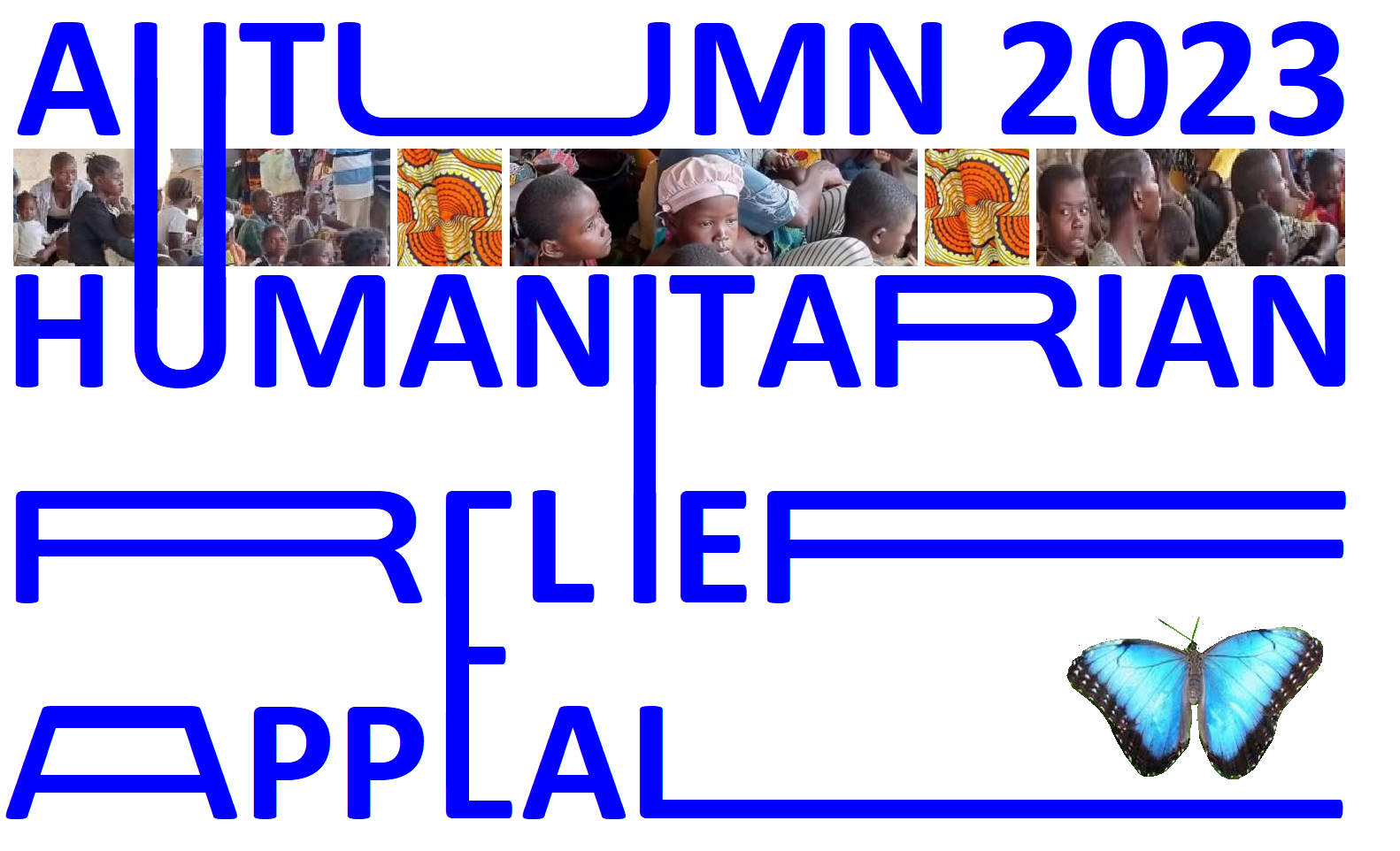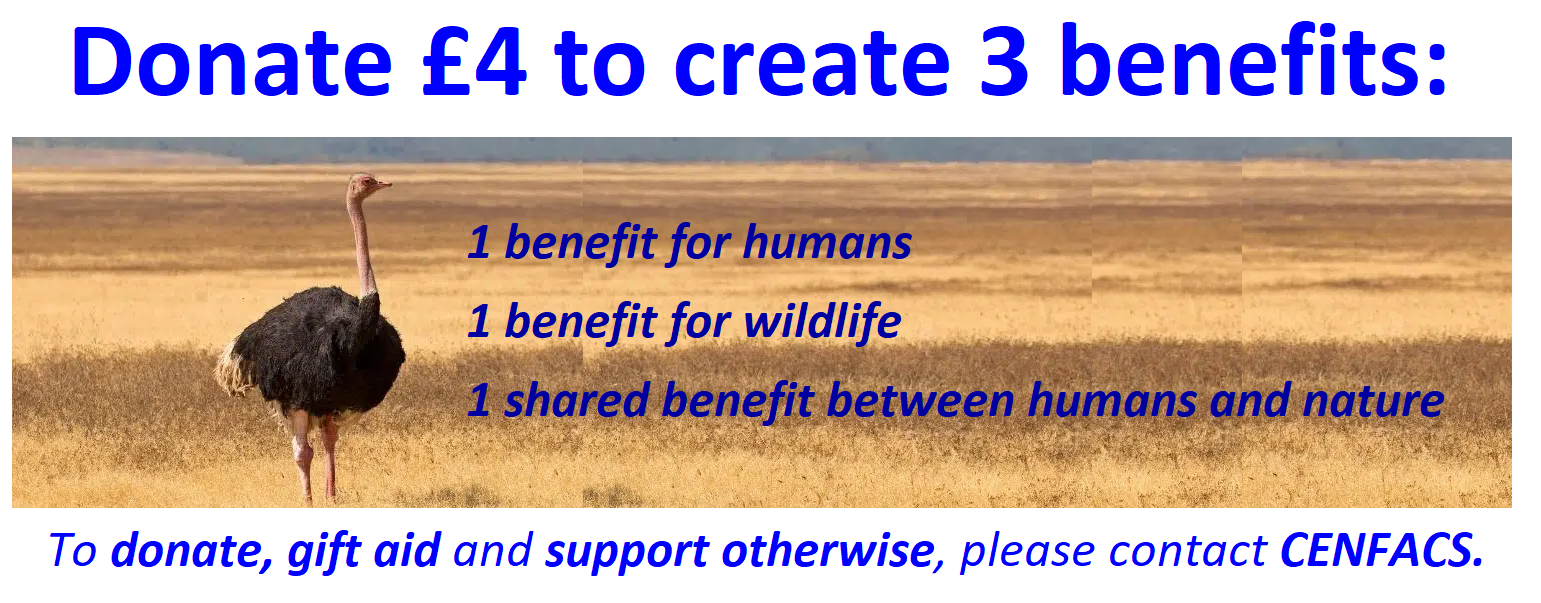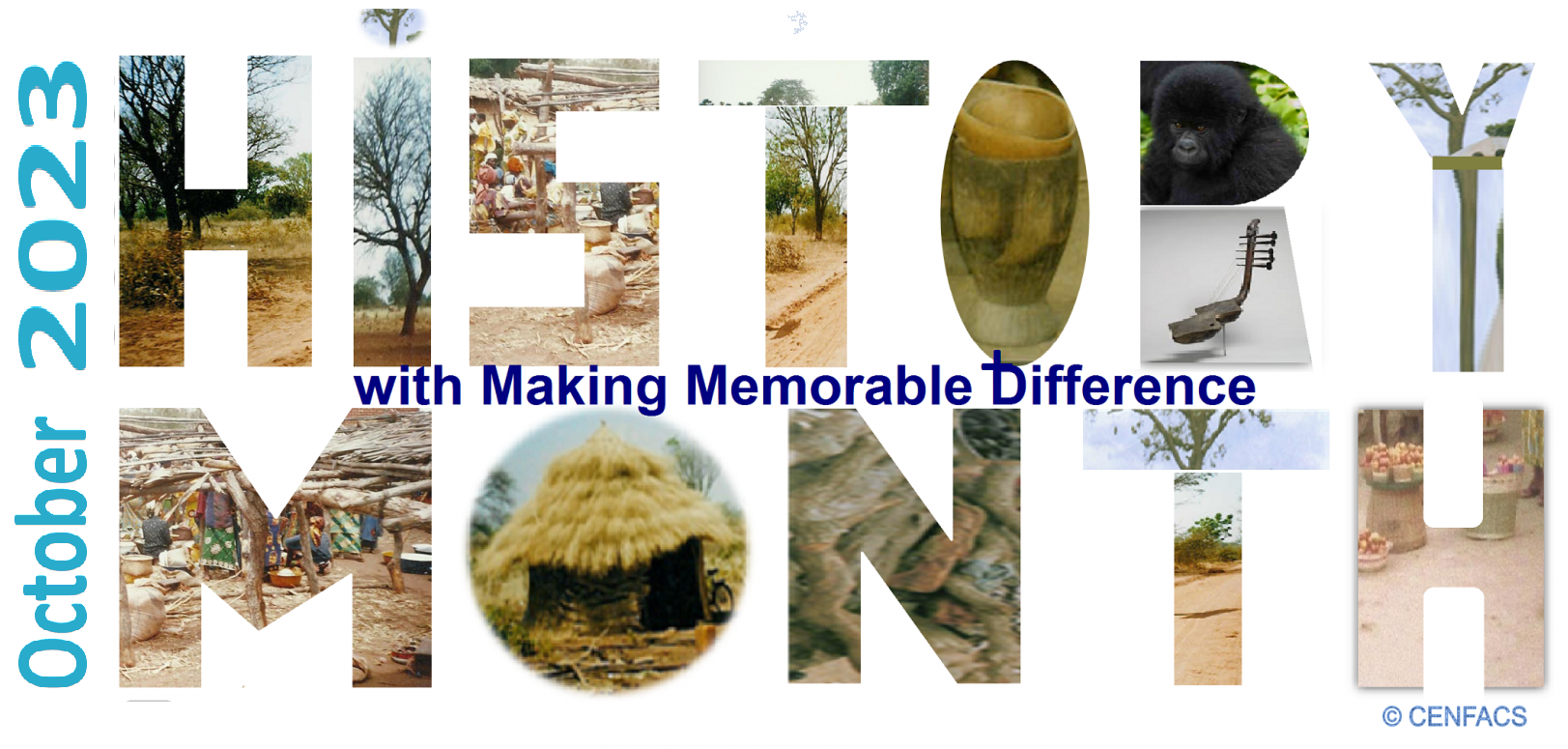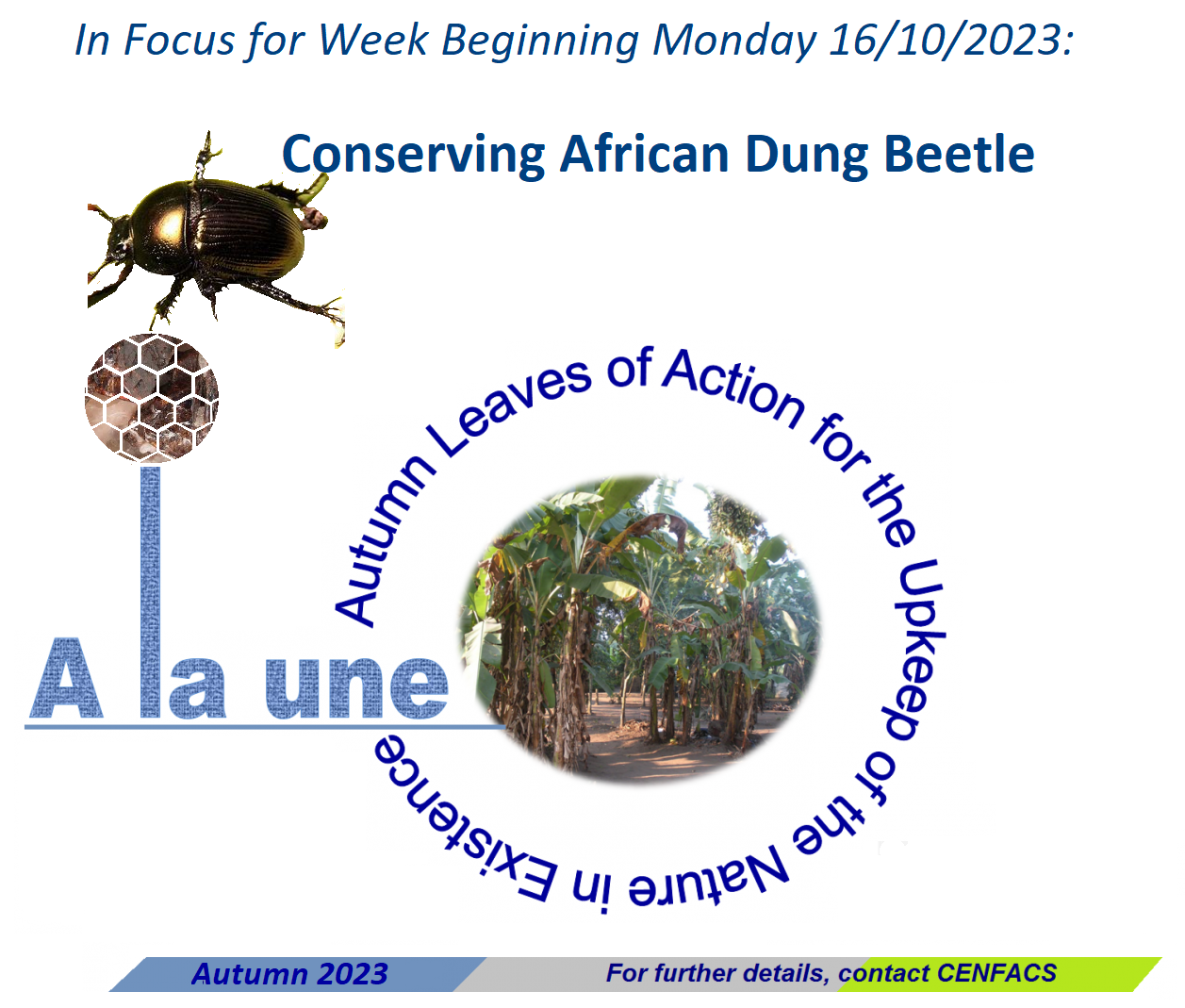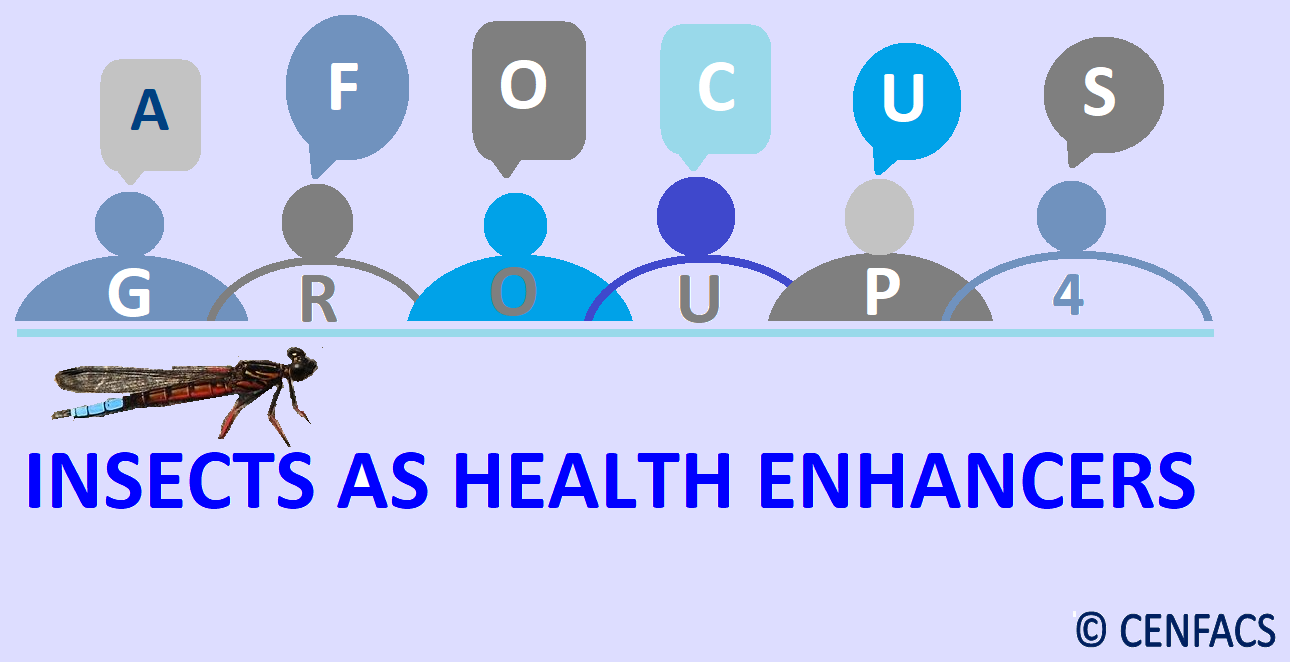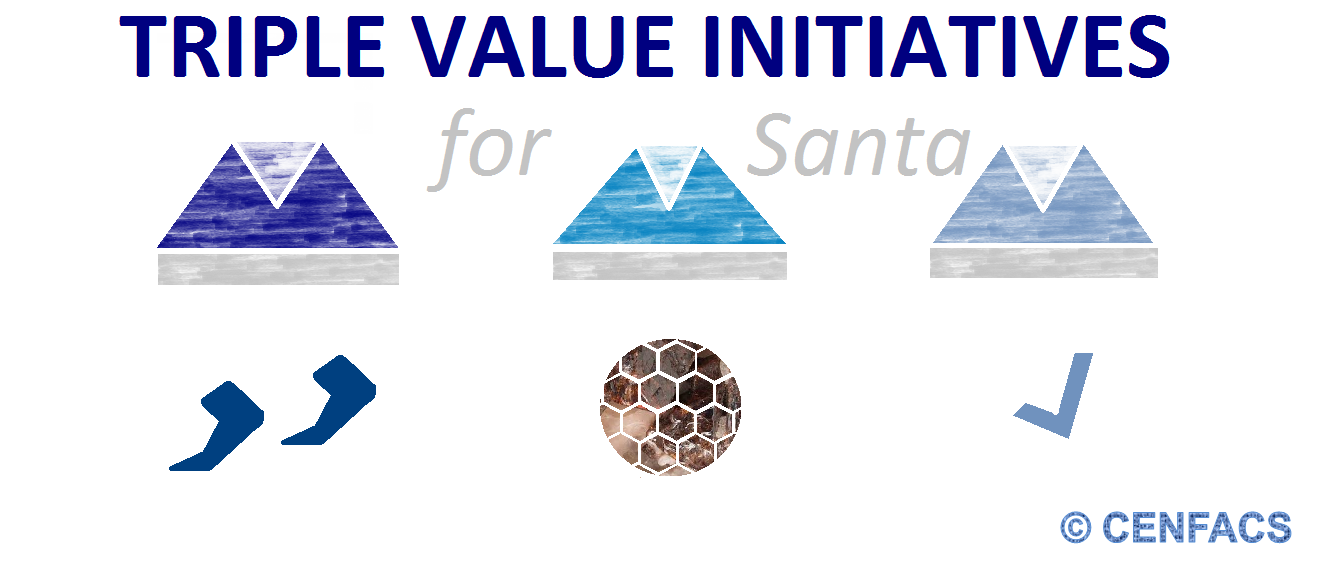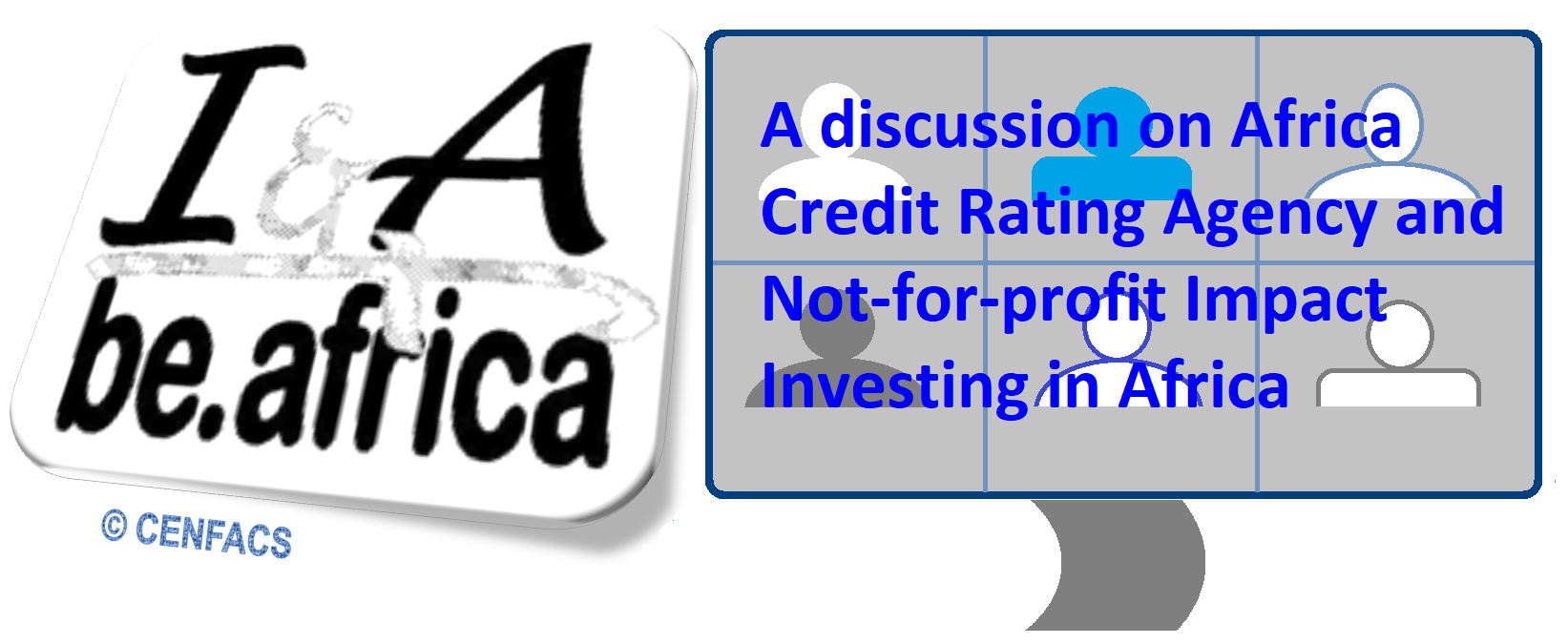Welcome to CENFACS’ Online Diary!
18 October 2023
Post No. 322
The Week’s Contents
• Autumn 2023 Humanitarian Relief Appeal
• “A la une” (Autumn Leaves of Action for the Upkeep of the Nature in Existence) Campaign and Themed Activities – In Focus for Week Beginning 16/10/2023: Conserving African Dung Beetle
• Review of Short-term Actions/Service under the Campaign to End Poverty Induced by Rising Costs of Living
… And much more!
Key Messages
• Autumn 2023 Humanitarian Relief Appeal
Needy People, Flora, Fauna, Funga, Communities and Organisations in Africa are Asking for Your Support!
Our humanitarian relief appeal for Autumn 2023 has now been launched as planned. This appeal is about supporting needy people, flora, fauna, funga, communities and organisations in Africa. It includes the following five selected projects:
1) Skills for Cross-border Trade and Economic Diversification
2) Symmetry Poverty Reduction Projects
3) Financial Inclusion of Women and Youth in Africa
4) Rescuing Children’s Education
5) Save Flora, Fauna and Funga Projects.
A brief summary of these projects can be found under the Main Development section of this post. The full project proposals of each project making this appeal is available should any of the potential donors or funders make a request.
Donors and funders can seize the opportunity provided by these projects and the giving season to directly and respectively donate or fund these projects.
A message about this appeal can also be passed on to a person who is in a position and willing to support. Many thanks to those who will be passing this message!
We understand that the world is still trying to find ways of coming out of many crises (food, energy, climate change, geo-economic crises, etc.). This struggle affects the ability of people to support good and deserving causes.
However, the effects of these crises are even stronger in places where there is a high level of poverty like in Africa. This is why we have launched this seasonal appeal to help not only to reduce poverty but also to save lives from these crises.
Therefore, we are inviting those who can, to donate £4 to create 3 benefits (1 benefit for humans, 1 benefit for other natural livings and 1 shared benefit between humans and nature) or any amount starting from £4 or more as you wish or can.
You can gift aid your donation as well as support these projects in a way that is the most suitable and related to your situation, circumstance, budget, capacity and willingness.
To donate, gift aid and support otherwise; please contact CENFACS.
• “A la une” (Autumn Leaves of Action for the Upkeep of the Nature in Existence) Campaign and Themed Activities – In Focus for Week Beginning 16/10/2023: Conserving African Dung Beetle
To converse African Dung Beetle, it is useful to highlight what we know about it and why one needs to converse it. Besides that, we shall introduce the insect themed activity we have planned for this week.
• • What We Know about African Dung Beetle?
According to ‘exploringnature.org’ (1),
“There are several different kinds (species) of dung beetle in Africa and thousands of different kinds all over the world, wherever there is dung. The African Dung Beetle – also called Neateuchus proboscideus – lives on grass land (savannah)”.
There are three main types of dung beetle which are rollers, tunnellers and dwellers. Dung beetles need to be conserved.
• • Why One Needs to Conserve an African Dung Beetle
There are several reasons which can militate in favour of the conservation of an African Dung Beetle. Amongst these reasons is its contribution to mitigate adverse climate change. This climate change reason can be found in what Jennifer S. Holland (2) explains which is as follows.
“Since Dung Beetles eat the poo from dairy cows and beef cattle, buffalo, sheep, goats – animals which emit more greenhouse gases than does the transportation industry and are responsible for a third of global emissions of methane – it is assumed that the poo-loving dung beetle can be a weapon in the battle against global warming. By digging around in the poo, the beetles make less methane to be produced within the pates”.
There are other reasons as to why one may need to conserve dung beetles. Philips et al. (3) tell us that dung beetles located in the Nimba Mountain Range Region are threatened since the region is threatened by human activities that both alter and fragment habitats and likely modify species distribution. The Nimba Mountain Range is located in the West African countries of Guinea, Cote d’Ivoire and Liberia, and is part of the Upper Guinean Forest ecosystem.
Similarly, ‘cfsph.iastate.edu’ (4) explains that
“Dung beetles are in danger. The biggest threat is from synthetic pesticides often used in conventional agriculture”.
Additionally, ‘upi.com’ (5) argues that
“Researchers suggest drugs used in veterinary medicine are pushing the beetles to the brink of extinction”.
Clearly, the above-mentioned body of works indicates that African Dung Beetle is in danger and threatened. It also provides us the actionable basis for conserving African Dung Beetles.
• • Add-on Activity of the Week’s Campaign: Focus Group on Insects as Health Enhancers
The insect themed activity of this week is on working in a small group on the gifts that insects provide to humans in terms of health. The group will contribute to an open discussion about insects’ gifts and enhancement to humans’ health. This activity kicks off with the article of Abby C. Nowakowski et al. (6) who argue the following:
“Edible insects may have high superior health benefits due to high levels of vitamin B12, iron, zinc, fiber, essential amino acids, omega-3 and omega-6 fatty acids, and antioxidants. The addition of edible insects such as crickets to the human diet could offer a myriad of environmental and nutritional benefits including an overall reduction in greenhouse gas emissions, decreased agricultural use of land and water, improved prevention and management of chronic diseases like diabetes, cancer, and cardiovascular disease and enhanced immune function”.
During the focus group, we shall explore the named benefits of edible insects in terms of health. We shall as well try to link particular edible insects to given health benefits they can provide.
Those who may be interested in taking part in this focus group or insect themed activity, they can contact CENFACS.
To find out more about the entire “A la une” Campaign and Themed Activities, please communicate with CENFACS.
• Review of Short-term Actions/Service under the Campaign to End Poverty Induced by Rising Costs of Living
We are continuing the Review of the Campaign to End Poverty Induced by Rising Costs of Living. This week, the Review is related to Short-term Actions/Service under this Campaign.
Short-term Actions/Service are critical actions or activities to be undertaken within six months period to work with those who are poor because of high costs of living to make ends meet. They are short-term protective support to be implemented before any humanitarian needs emerge or materialise within the community. These actions are part of the service we are providing to support the community.
To review short-term actions or service, we are examining the following:
√ the assessment we carried out with users about how the cost-of-living crisis would have affected them and their needs as a result of crisis effects
√ the action plan we drew with users to tackle the effects of the cost-of-living crisis
√ the Guidance, Advice and Information on organisations that would have offered goods and services that could be accessible and affordable for users
√ the Guidance, Advice, Referrals, Signposting and Information about support and benefits available for distressed households’ accounts and assets
Etc.
The review will enable to know what has worked and did not work in the context of Short-term Actions/Service under the Campaign to End Poverty Induced by Rising Costs of Living.
For any queries about this review, please contact CENFACS.
Extra Messages
∝ Online Micro-volunteering Activities with CENFACS
∝ Triple Value Initiatives for Santa: Raising Funds while Playing, Running and Voting for Poverty Reduction over the Long Festive Period
∝ CENFACS’ be.Africa Discusses the Africa Credit Rating Agency and Not-for-profit Impact Investing in Africa
• Online Micro-volunteering Activities with CENFACS
As well as supporting CENFACS and its noble causes with no direct cash donations, people can add up or think of alternative ways of involving with CENFACS. For example, they can micro-volunteer with us either online or offline or both.
To enable our readers and those who may be interested in micro-volunteering with us to understand what we are talking, let us explain the following jargons: micro-volunteering, smart tasks, smart communications tools and smart poverty relief.
• • What is Micro-volunteering with CENFACS?
It is about undertaking or completing small tasks, that can be online or offline or both, to make up one of our main projects. While we recognise the importance of both online and offline tasks in our volunteering scheme (All in Development Volunteers), our focus on micro-volunteering in the context of this post will be on the online part of it.
• • Online Micro-volunteering Doing Small Smart Tasks
Small tasks are micro-actions. From what Anna Patton said (7), these tasks need to be easy, no-commitment, cost-free, to take less than 30 minutes to complete, little or no formal agreement needed before a volunteer can get started, and no expectation that the volunteer will return, no long-term commitment for the volunteer.
These tasks could be smart, that is specific, measurable, achievable, realistic and timely; as well as capable of generating and increasing support towards CENFACS’ good and deserving causes, especially at the time of the cost-of-living crisis. These tasks can contribute to smart poverty relief.
The above table (table no.1) briefly provides a summary of these tasks. For those who would like to dive into online micro-volunteering small smart tasks, they can contact CENFACS’ All in Development Volunteers Scheme.
• • Online Micro-volunteering Done via Smart Communication Tools
It is the use of internet connected devices or tools (such as smart phones, tablets, video calling devices, notebooks, laptops, cameras, drones, Artificial Intelligence enabled tools, etc.) to re-engage with CENFACS audience and supporters as well as to recruit new supporters.
Smart communication tools include as well other devices designed to run or complete actions carried out by smart phones, tablets, notebooks, etc. These extra tools could be wireless printers, broad bands, messenger apps and so on.
Additionally, online micro-volunteering by using distance working and online technologies in our campaigns can help us to reach out to our supporters and Africa-based Organisations.
We understand that not every volunteer can afford to have them. This is why we often ask support with smart communication tools so that our volunteers (All in Development Volunteers) could be able to micro-volunteer smarter and deliver smart poverty relief.
• • Online Micro-volunteering to Achieve Smart Poverty Relief
This additional way of working and engaging with our audience and supporters via online micro-volunteering has brought some opportunities and benefits. Amongst these opportunities or openings is that of creating smart relief, of reducing poverty symptoms for temporary relief which could lead to permanent relief.
In this respect, smart poverty relief is about prioritising resources and making sure that CENFACS’ poverty reduction system is helping to meet the needs of those in need as we undertake online micro-volunteering activities.
In other words, when volunteers carry out micro-actions, they are not doing them for the sake of entertaining themselves or just passing their time with and for CENFACS.
Through their small online tasks, they are bringing their contribution, however little it can be, to the larger project or programme or picture of CENFACS. By adding up their small pieces of work/relief, one can get the sum of poverty relief, a big poverty relief. Online micro-volunteering could be smart when it contributes to the big picture of poverty reduction.
To enable us to continue our voluntary work, we are asking to those who can, both individuals and organisations, to support us with smart communication tools to enhance our online micro-volunteering action.
To support CENFACS with Smart Communication Tools to micro-volunteer doing Smart Tasks to deliver Smart Poverty Relief, please contact CENFACS.
• Triple Value Initiatives for Santa: Raising Funds while Playing, Running and Voting for Poverty Reduction over the Long Festive Period
You can help CENFACS raise life-saving funds it needs for its good causes by making participants or interested parties to Triple Value Initiatives (or All-year Round Projects) to dress like Santa.
Participants and vested parties can then donate or sponsor your Triple Value Initiatives of Playing, Running and Voting for poverty reduction.
The income to be raised on these occasions can be donated to CENFACS. It will help to support those in most need so that they can navigate their way out of poverty and hardships.
However, to raise funds via Triple Value Initiatives for Santa, one needs to first discuss the matter, their plan/idea with CENFACS. Together with them, we can better plan their/our fundraising drive and help deliver it in a smooth and hassle-free way while following the rules of the game.
To raise funds for Triple Value Initiatives for Santa to help CENFACS and its noble causes, please contact CENFACS.
Just remember, do not forget to record and report your scores, results and fixtures about your Triple Value Initiatives (or All year-round Projects). At the end of the process of All year-round Projects and by the end of the year, one should be ready to announce the 2023 Action-Results for either of the project: Run or Play or Vote.
The final Action-Results will consist of finding out and revealing the following for this year:
√ The Best African Countries of 2023 which would have best reduced poverty
√ The Best African Global Games Runners of 2023
√ The Best African Development and Poverty Relief Managers of 2023.
If you have not yet thought about this finding or revelation, please start thinking right now and have your say about it by the 23rd of December 2023!
∝ CENFACS’ be.Africa e-Discusses the Africa Credit Rating Agency and Not-for-profit Impact Investing in Africa
Further to the United Nations Economic Commission for Africa’s report (8), the African Union is planning to create in 2024 a new sovereign credit rating agency.
A credit rating agency is – by definition of ‘accounntingtools.com’ (9) – “a company that reviews the creditworthiness of an entity that is in the process of or has already issued debt. The resulting credit ratings are used by investors to evaluate whether [or not] they should invest debt securities”.
The best known credit rating agencies are Moody’s, Standard and Poor’s and Fitch.
As a result of the African Union’s planning decision, CENFACS’ be.Africa is e-discussing the implications of a newly created Africa Credit Rating Agency for the not-for-profit investors in Africa, in particular those who would like to not-for-profit invest in Africa with impact.
For the purpose of this e-discussion, one needs to understand not-for-profit impact investing. According to ‘evpa.ngo’ (10),
“Investing for impact is an impact strategy followed by investors that adopt the venture philanthropy approach to support social purpose organisations maximising their social impact. Investors for impact support innovative solutions to pressing societal issues, providing in-depth non-financial support and taking on risks that most of other actors in the market cannot – or are not willing to take”.
This definition can be applied to those investors who do not consider profit as their first or main aim or goal. They can be called not-for-profit investors.
Knowing the two concepts (i.e., credit rating agency and not-for-profit impact investing), it is possible to e-debate the following matters or questions:
σ How can Africa Credit Rating Agency (ACRA) help the flow of capital into Africa’s not-for-profit organisations and sector?
σ The extent to which ACRA can assist these organisations in understanding African credit instruments and financial products as well as internalise these instruments and products in their strategic operations
σ Can ACRA improve confidence amongst not-for-profit investors on poverty reduction markets?
σ Will ACRA provide to not-for-profit investors a comprehensive appreciation and outlook of Africa’s not-for-profit environment?
σ How objective will funding on poverty reduction be based on as a result of a new credit rating agency in Africa?
σ What kinds of facilities and opportunities will ACRA open up for not-for-profit organisations in Africa?
The above are some of the issues and questions we are trying to discuss and find answers.
Those who may be interested in this discussion can join in and or contribute by contacting CENFACS’ be.Africa, which is a forum for discussion on matters and themes of poverty reduction and sustainable development in Africa and which acts on behalf of its members in making proposals or ideas for actions for a better Africa.
To communicate with CENFACS regarding this discussion, please use our usual contact details on this website.
Message in French (Message en français)
Le Forum ‘Une Afrique Meilleure’ de CENFACS discute en ligne de l’Agence de Notation de Crédit Africaine (ANCA) et de l’investissement d’impact à but non lucratif en Afrique
Suite au rapport de la Commission Économique des Nations Unies pour l’Afrique (8), l’Union Africaine envisage de créer en 2024 une nouvelle agence de notation de crédit souveraine.
Une agence de notation de crédit est, par définition de « accounntingtools.com » (9), « une entreprise qui examine la solvabilité d’une entité qui est en train d’émettre ou qui a déjà émis de la dette. Les notations de crédit qui en résultent sont utilisées par les investisseurs pour évaluer s’ils doivent investir dans des titres de créance.
Les agences de notation de crédit les plus connues sont Moody’s, Standard & Poor’s et Fitch.
À la suite de cette décision de planification de l’Union Africaine, le Forum ‘Une Afrique Meilleure’ de CENFACS discute en ligne des implications de la création d’une agence de notation de crédit africaine pour les investisseurs à but non lucratif en Afrique, en particulier ceux qui souhaitent investir en Afrique avec un impact.
Aux fins de cette discussion en ligne, il faut comprendre l’investissement d’impact à but non lucratif. D’après « evpa.ngo » (10),
« Investir pour avoir un impact est une stratégie d’impact suivie par les investisseurs qui adoptent l’approche de la philanthropie de capital-risque pour aider les organisations à vocation sociale à maximiser leur impact social. Les investisseurs d’impact soutiennent des solutions innovantes à des problèmes sociétaux urgents, en fournissant un soutien non financier approfondi et en prenant des risques que la plupart des autres acteurs du marché ne peuvent pas – ou ne veulent pas prendre ».
Cette définition peut s’appliquer aux investisseurs qui ne considèrent pas le profit comme leur premier but ou objectif. On peut les appeler des investisseurs à but non lucratif.
Connaissant les deux concepts (c’est-à-dire l’agence de notation de crédit et l’investissement d’impact à but non lucratif), il est possible de débattre en ligne des questions suivantes :
σ Comment l’Agence Africaine de Notation de Crédit (ANCA) peut-elle faciliter l’afflux de capitaux vers les organisations et le secteur à but non lucratif en Afrique?
σ Dans quelle mesure l’ANCA peut aider ces organisations à comprendre les instruments de crédit et les produits financiers africains, ainsi qu’à internaliser ces instruments et produits dans leurs opérations stratégiques?
σ L’ANCA peut-elle améliorer la confiance des investisseurs à but non lucratif dans les marchés de la réduction de la pauvreté?
σ L’ANCA fournira-t-elle aux investisseurs à but non lucratif une appréciation et des perspectives complètes de l’environnement des organisations à but non lucratif en Afrique?
σ Sur quels critères objectifs le financement de la réduction de la pauvreté sera-t-il fondé à la suite de la création d’une nouvelle agence de notation de crédit en Afrique?
σ Quels types d’installations et d’opportunités l’ANCA ouvrira-t-elle aux organisations à but non lucratif en Afrique?
Ce qui précède sont quelques-uns des problèmes et des questions que nous essayons de discuter et de trouver des réponses.
Les personnes susceptibles d’être intéressées par cette discussion peuvent y participer et/ou y contribuer en contactant le me.Afrique du CENFACS (ou le Forum ‘Une Afrique Meilleure’ de CENFACS), qui est un forum de discussion sur les questions et les thèmes de la réduction de la pauvreté et du développement durable en Afrique et qui agit au nom de ses membres en faisant des propositions ou des idées d’actions pour une Afrique meilleure.
Pour communiquer avec le CENFACS au sujet de cette discussion, veuillez utiliser nos coordonnées habituelles sur ce site Web.
Main Development
• Autumn 2023 Humanitarian Relief Appeal
Needy People, Flora, Fauna, Funga, Communities and Organisations in Africa are Asking for your Support!
The following items summarise their appeal:
∝ The data that justify the need to help
∝ The projects
∝ The request
∝ The beneficiaries
∝ The asks
∝ What your donation can achieve
∝ How to send your support.
Let us unpack each of these items.
• • The data that justify the need to help
The data (or information in words and numbers) that tell us there is a humanitarian need to support are given in the following examples – data from individuals and multilateral agencies working on poverty matter.
For example, studying economic diversification and the Theil Index (i.e., economic diversification measure), Zainab Usman and David Landry (11) explain that
“Countries in Sub-Saharan African account for only 2 percent of global economic activity even though the region is home to 14 percent of the world”.
Writing on inequality, the United Nations Development Programme (12) in its latest development report found that
“Inequality in income was 27.1% and inequality in education was 34.3% in 2021 in Sub-Saharan Africa” (p. 284)
Studying financial inclusion in Africa, Majorie Chalwe-Mulenga and Gerhard Coetzee (13) explain that
“In Sub-Saharan Africa, the gender gap in account ownership rose from 5% in 2011 to 12% in 2021, triple the global average and double that of other developing regions”.
Reporting on technology in education, the United Nations Educational, Scientific and Cultural Organisation (14) states that
“The out-of-school population in Sub-Saharan Africa increased by 12 million over 2015-21“.
Analysing the kinds of threats and dangers that species face in Africa, ‘earth.org’ (15) lists ten most endangered species in Africa, which are Black Rhino, African Elephant, Gorilla, Saharan Cheetah, African Wild Dog, African Penguin, North African Ostrich, Dama Gazelle, Egyptian Tortoise, and Sahara Aphanius.
Likewise, in its State of the World’s Plants and Fungi report, ‘kew.org’ (16) provides five key extinction risks facing the world’s plants and fungi, which are as follows: extinction of three in four unknown plant species; the detrimental impacts of climate change on fungi; plants are extinct 500 times faster than before humans existed; known fungi species have the risk of extinction for less than 1%; and nearly half of flowering plant species are under threat.
What the above-mentioned pieces of information and facts tell us. They indicate the following.
Whether it is about economic diversification or inequality reduction or inequality between the two sexes or gender gap in account ownership or out-of-school population, the above data just highlight the underlying problem of poverty and extreme poverty in Africa. One part of the above-mentioned figures and facts also indicates the continuing threats to wildlife and the lack of skills in some situations to navigate out of poverty and hardships.
Furthermore, as the global cost-of-living crisis continues the figures about poverty and threats to the wildlife could be different; meaning that poor people, children, women, flora, fauna and funga could be in a worse scenario case or situation in which humanitarian relief could be part of the response. Data-based solutions to poverty induced by the cost-of-living crisis can only help this situation, especially in the long term.
These above data from multilateral agencies as well as those from individual researchers finally highlight CENFACS‘ findings and the reality on the ground in Africa in the area of operation of CENFACS. There is need out there that deservingly requires support that the locals are requesting to address existing humanitarian needs, especially at this time of the difficult global economic situation exacerbated by the effects of geo-economic and insecurity crises.
• • The projects
Five projects to help reduce poverty and meet the needs of the local people, animals, plants, fungi and organisations this Autumn and beyond
1) Skills for Cross-border Trade and Economic Diversification (Learning and Skills Development Project)
This is a project that helps to reduce poverty linked to poor or incomplete skills, knowledge, information and capacities amongst those running income-generating activities through cross-borders in Africa. The project is designed to support growth and decent way of generating income for those poor people trading between borders of African countries in order to reduce poverty.
The project is not only about specialising in a particular way of generating income. It is also or even more about carrying out structural transformation in the way poor traders and small producers are trying to respectively trade and produce. The project will help in the development of skills for cross-border trade and economic diversification. The skills are the knowledge, abilities, values and attitudes needed to better trade and economically diversify.
2) Save Flora, Fauna and Funga Projects (Environmental Projects)
These are wildlife preservation, conservation and protection initiatives which help to advance justice and equity for flora, fauna and funga, and which include three areas of action:
a) Life-saving actions against new forms of exploitation and trafficking of animal, bird and plant species
b) Life-saving action against the cost-of-living crisis on flora and fauna
c) Life-saving actions to reduce the impacts of climate change on fungi.
The first action is an action to protect animal and bird species in Africa from new forms of wildlife exploitation and trafficking, including kidnapping of animals from their natural sanctuary.
For example, in North-Kivu (the Eastern part of the Democratic Republic of Cong0), there are armed groups that set up their bases in the vicinity of parks like the park Virunga, which is sanctuary of very rare mountain gorillas. These groups threatened protected ecosystems by exploiting natural resources (such as woods and animals) via poaching, illegal fishing, smuggling, kidnappings of animals, etc. Specimen and trophies from elephant ivory, charcoal and illicit fishing are traded by these groups to finance their supply of arms and to engage in armed conflicts.
The second action is about making sure that, plant and animal species regain, restore, rebuild and thrive their lives while humans are trying to deal with the cost-of-living crisis. In other words, the action is about to ensure that the cost-of-living crisis does not lead to flora and fauna crises since we depend on them in order to come out of the cost-of-living crisis.
The third action is about lowering the risk of extinction facing fungi.
3) Symmetry Poverty Reduction Projects (Equality Projects)
Symmetry Poverty Reduction Projects can be of various kinds within CENFACS. The first wave or generation of symmetry projects was to address the unfair distributional effects of the coronavirus. This first wave or generation of Symmetry Poverty Reduction Projects was implemented during the period of the coronavirus (from Autumn 2019 to Autumn 2021).
This Autumn’s Symmetry Projects, which are the continuation of 2022 Autumn’s Symmetry Projects, are sustainable development initiatives aiming at reducing the difference in the distributional effects of rising costs of living that have been asymmetrical or uneven. In this second wave or generation of Symmetry Poverty Reduction Projects, there are projects of working with local poor people in parts of Africa where there is uneven impact of the cost-of-living crisis and poverty reduction in order to establish equal right and address the historical roots and causes of this type of asymmetry or inequality in a sustainable way.
4) Financial Inclusion of Women and Youth in Africa (Financial Inclusion Project)
According to Jack Onyisi Abebe et al. (17),
“Financial inclusion goes beyond improved access to credit to encompass enhanced access to savings and risk mitigation products, a well-functioning financial infrastructure that allows women and women-owned enterprises to engage more actively in the economy, while protecting their rights” (p.11)
Since financial inclusion refers to all segments of the population, we are including Africa’s youths, particularly girls, to be supported to access available and affordable financial services.
Financial Inclusion of Women and Youth in Africa tries to address the poverty of the historically excluded (here women and youths) from the formal financial sector for various reasons (be it income or gender or customs or age or level of financial literacy and numeracy or tribe, etc.). The project will try to reduce poverty and discrimination linked to financial exclusion towards the contribution that women and young people, particularly young girls, are making or can make in their own development as well as the development process in Africa.
5) Rescuing Children’s Education (Educational Hardship Reduction Project)
There are two aspects in this project which are maintaining school momentum in places where there is no crisis and rescuing education in crises-stricken places.
a) Maintaining school momentum
One thing is for a child to go back to school; another thing is for the same child to stay in the school/educational system. Rescuing Children’s Education Project is an educational support to poor children facing poverty barriers to go back to schools, to stay in the school system and cope with the pressure of the educational requirements.
To maintain school momentum, the project will help these children to keep school engagement process, to meet their educational goal setting, to be motivated toward learning, to improve their schooling habits, to get organisational tools they need for their schooling and maintain excitement during the school year.
b) Educational rescue
This second aspect is about rescuing the education of children whose curriculum has been disrupted because of the consequences of conflicts and natural disasters.
To rescue education for children victims of conflicts and natural disasters, support can be given to help them learn and engage with school by distance if their school is closed because of the consequences of wars and / or natural disasters. For those children where schools have been reopen after conflicts and natural disasters, they need support too.
In total, 5 projects to donate £4 to create 3 benefits as you wish per project
Note: Further details about the above projects are available on request from CENFACS.
• • The request
The beneficiaries of the above projects are local poor people (children), flora, fauna and funga under threat as well as Africa-based Organisations that CENFACS works with to help reduce the following types of poverty and hardships:
• Poor or lack of basic infrastructures (such as safe drinking water collection points, medical and health centres, toilets and washing essentials, places to get training and basic education, online necessary equipment, lack of personal protective equipment to stop the spread of diseases, etc.) to secure safe drinking water, to educate children, to sanitise health and access primary health care, etc.
• Lack of animal protection and care, threats to extinction or killings, trafficking and poaching of endangered animals (like the elephants, gorillas, rhinoceros, etc.), plant species (such as maize, potato, bean, squash, chilli pepper, vanilla, avocado, husk tomato and cotton crops), bird species (e.g., African Grey Parrots, Congo Peafowl, African Green Broadhill, etc.) and fungi species (e.g., mushrooms, moulds, mildews, and yeasts)
• Wildlife crime through illegal harvest of and trade in wildlife and forest products as well as derived products
• Lack of skills for trade and economic diversification, income poverty and dehumanising treatment afflicted to poor particularly women, young girls and children
• Asymmetrical economic effects of the cost-of-living crisis whereby those who are poor do not have the same sort of support than others to cope with the mounting or crippling effects of the cost-of-living crisis as well as they cannot move out of the vicious circle of deprivations
• lack of financial inclusion and little financial involvement of women (particularly in rural areas) and the youth, particularly young girls, in the financial sector; yet women and youths can play an active role in Africa’s resilient recovery efforts
• Lack of income and or enough earnings by poor families to send their children back to school and/or for these children to keep school momentum
• Lack of support in places where school infrastructures and educational premises have been destroyed by wars and natural events.
• • The beneficiaries
This Autumn 2023 humanitarian relief appeal will help…
√ The real and direct beneficiaries and end users who are poor people (amongst them the youth, young girls and children)
√ The endangered animal, bird, plant and fungus species
√ The indirect beneficiaries made of African organisations based in Africa and working on the issues/causes of these poor people and species.
• • The asks
The above needy people, flora, fauna, funga, communities and organisations need your support.
CENFACS is appealing to you to donate £4 to create 3 benefits (1 benefit for humans; 1 benefit for animals, birds and plants; and 1 benefit for both humans and nature) as you wish to achieve penultimate relief.
• • What your donation can achieve
If you donate £4 to create 3 benefits, we can anticipate the following use and relief impacts that these amounts can help
⇒ To implement Skills for Cross-border Trade and Economic Diversification by…
√ identifying gaps in trade capability and enhancing beneficiaries’ knowledge and application skills to better trade
√ creating a shift toward a more varied structure of beneficiaries’ income generation drive and production to make ends meet.
For example, £4 can help provide a tablet or phone to help beneficiaries run their income-generating activities, acquire high street digital trade skills and learn cross-border legislation.
⇒ To deliver Save Flora, Fauna and Funga projects by…
√ running wildlife protection awareness campaign to address illicit trafficking in wildlife and to keep advocacy on wild animals’, birds’, plants’ and fungi’s rights and welfare
√ buying or developing software or apps on protection and care of animal, bird, plant and fungus species in Africa.
For example, £4 can help rescue animals from their kidnappers and rehabilitate rescued animals (e.g., African Grey Parrots) at a rescued animal rehabilitation centre.
⇒ To execute Symmetry Poverty Reduction Projects by…
√ running online and virtual equality workshops on the reduction of asymmetrical adverse effects of the cost-of-living crisis between people and ethnic groups
√ training people to tackle inequalities of poverty reduction or treatment induced by the cost-of-living crisis within their communities.
For example, £4 can help a poor family to access clean energy to prepare a meal while reducing the uneven distributional consequences of the cost-of-living crisis.
⇒ To close the financial inclusion gaps for women and youths, particularly young girls in Africa by…
√ helping the unbanked women and youths to access the documentation required to open a financial account and build their financial health
√ supporting African voluntary organisations to advocate financial inclusion of women and youths as well as help deploy financial services and products towards them.
For example, £4 can help pay for childcare and other care services so that young girls can study and engage in the financial sector in Africa in a gender-aware and inclusive way.
⇒ To realise back-to-school support, maintain school momentum and rescue needy children’s education by…
√ supporting the recovery of learning losses, teacher training and extra health service for the children traumatised by the effects of conflicts and natural disasters on their education and well-being
√ purchasing school e-books and e-materials through African voluntary organisations to help educationally needy children to add distance learning opportunities to their education in order to mitigate the adverse effects of the cost-of-living crisis on children’s learning and abilities.
For example, £4 can enable poor families to buy organisational tools and to access motivational programmes for children to stay engaged with the schooling process and educational system.
To realise a total of 5 lasting benefits, it may require a donation of £10 to £20 or even more.
To smooth the process of supporting the above-mentioned beneficiaries, CENFACS is ready to post to you and or to any other potential supporters the project proposals or an information pack about them for consideration to support. Likewise, CENFACS is ready to talk to you or to potential funders about them if they want us to do so.
To donate, gift aid and or support differently, please contact CENFACS.
• • How to send you support
You can donate
* over phone
* via email
* through text
* by filling the contact form on this website.
On receipt of your intent to donate or donation, CENFACS will contact you. However, should you wish your support to remain anonymous; we will respect your wish.
We look forward to your support with helpful difference for the Poor People, Organisations and Wildlife Species in Africa.
Thank you in anticipation for your willingness to give and help change the lives of these poor people, organisations and wild species.
_________
• References
(1) https://www.exploringnature.org/db/view/Beetle-African-Dung (accessed in October 2023)
(2) https://www.nationalgeographic.com/animals/article/130904-dung-beetles-global-warning-animals-science (accessed in October 2023)
(3) Philips, T. K., Bowen, J.G., Soumah, A.G. et al., Dung Beetle (Coleoptera: Scarabaeidae, Scarabaeinae) diversity of the highest elevation in West Africa: the Nimba Mountain Range, International Journal of Tropical Insect Science 43, 1097-1109 (2023), https://doi,org/10.1007/s42690-023-01017-3 (accessed in October 2023)
(4) https://www.cfsph.iastate.edu/thelivestockproject/dung-beetles-the-organic-alternative-farmers-hidden-helper/ (accessed in October 2023)
(5) https://www.upi.com/science_News/2019/09/24/Veterinary-drugs-pushing-dung-beetles-to-the-brink-of-extinction/3361569346377/ (accessed in October 2023)
(6) Nowakowski, A. C., Miller, A. C., Miller, M. E., Xiao, H., & Wu, X. (2022), Potential health benefits of edible insects, Critical reviews in Food Science and Nutrition, 62:13, 3499-3508, DOI: 10.1080/10408398.2020.1867053 (accessed in October 2023)
(7) Patton, A., 2021, Micro-volunteering, Making a Difference in Minutes, (Originally published Dec. 2017) at https://www.missionbox.com/article/183/micro-volunteering-making-a-difference-in-minutes (accessed October 2023)
(8) United Nations Economic Commission for Africa; African Union (2023), Africa sovereign credit rating review: 2023 mid-year outlook, Addis Ababa, @UNECA
(9) https://www.accountingtools.com/articles/credit-rating-agency (accessed in October 2023)
(10) https://www.evpa.ngo/impact-glossary (accessed in March 2023)
(11) Usman, Z. & Landry, D. (2021), Economic Diversification in Africa: How and Why It Matters at https://carnegieendowment.org/2021/04/30/economic-diversification-in-africa-how-and-why-it-mattters-pub-84429 (accessed in October 2023)
(12) United Nations Development Programme, 2022, Development Report 2021/2022 Uncertain Times, Unsettled Lives: Shaping our Future in a Transforming World, New York, USA
(13) https://www.cgap.org/blog/findex-2021-insights-boosting-financial-inclusion-in-africa (accessed in October 2023)
(14) UNESCO (2023), Global Education Monitoring Report Summary 2023: Technology in Education: A tool on whose terms? Paris, UNESCO
(15) https://earth.org/endangered-species-in-africa/ (accessed in October 2023)
(16) https://www.kew.org/science/state-of-the-world’s-plants-and-fungi (accessed in October 2023)
(17) Abebe, J. O., Maina, L., Ondick, J. and Ogolla, C. (2017), Driving Gender-Responsive Financial Inclusion Models in Africa – Background Paper, UN Women East and Southern Africa, Regional Office, Naïrobi
_________
• Help CENFACS Keep the Poverty Relief Work Going this Year
We do our work on a very small budget and on a voluntary basis. Making a donation will show us you value our work and support CENFACS’ work, which is currently offered as a free service.
One could also consider a recurring donation to CENFACS in the future.
Additionally, we would like to inform you that planned gifting is always an option for giving at CENFACS. Likewise, CENFACS accepts matching gifts from companies running a gift-matching programme.
Donate to support CENFACS!
FOR ONLY £1, YOU CAN SUPPORT CENFACS AND CENFACS’ NOBLE CAUSES OF POVERTY REDUCTION.
JUST GO TO: Support Causes – (cenfacs.org.uk)
Thank you for visiting CENFACS website and reading this post.
Thank you as well to those who made or make comments about our weekly posts.
We look forward to receiving your regular visits and continuing support throughout 2023 and beyond.
With many thanks.
